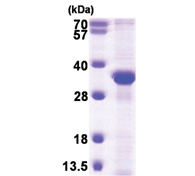RPA2 (1-270, His-tag) Human Protein
Other products for "RPA2"
Specifications
| Product Data | |
| Species | Human |
| Expression Host | E. coli |
| Expression cDNA Clone or AA Sequence |
MGSSHHHHHH SSGLVPRGSH MGSMWNSGFE SYGSSSYGGA GGYTQSPGGF GSPAPSQAEK KSRARAQHIV PCTISQLLSA TLVDEVFRIG NVEISQVTIV GIIRHAEKAP TNIVYKIDDM TAAPMDVRQW VDTDDTSSEN TVVPPETYVK VAGHLRSFQN KKSLVAFKIM PLEDMNEFTT HILEVINAHM VLSKANSQPS AGRAPISNPG MSEAGNFGGN SFMPANGLTV AQNQVLNLIK ACPRPEGLNF QDLKNQLKHM SVSSIKQAVD FLSNEGHIYS TVDDDHFKST DAE
|
| Tag | His-tag |
| Predicted MW | 31.7 kDa |
| Concentration | lot specific |
| Purity | >85% |
| Presentation | Purified |
| Buffer | Presentation State: Purified State: Liquid purified protein Buffer System: 20 mM Tris-HCl buffer (pH 8.0) containing 10% glycerol, 2 mM DTT, 0.1M NaCl |
| Preparation | Liquid purified protein |
| Protein Description | Recombinant human RPA2 protein, fused to His-tag at N-terminus, was expressed in E.coli and purified by using conventional chromatography techniques. |
| Storage | Store undiluted at 2-8°C for up to two weeks or (in aliquots) at -20°C or -70°C for longer. Avoid repeated freezing and thawing. |
| Stability | Shelf life: one year from despatch. |
| Reference Data | |
| RefSeq | NP_001273005 |
| Locus ID | 6118 |
| UniProt ID | P15927, B4DUL2 |
| Cytogenetics | 1p35.3 |
| Synonyms | REPA2; RP-A p32; RP-A p34; RPA32 |
| Summary | This gene encodes a subunit of the heterotrimeric Replication Protein A (RPA) complex, which binds to single-stranded DNA (ssDNA), forming a nucleoprotein complex that plays an important role in DNA metabolism, being involved in DNA replication, repair, recombination, telomere maintenance, and co-ordinating the cellular response to DNA damage through activation of the ataxia telangiectasia and Rad3-related protein (ATR) kinase. The RPA complex protects single-stranded DNA from nucleases, prevents formation of secondary structures that would interfere with repair, and co-ordinates the recruitment and departure of different genome maintenance factors. The heterotrimeric complex has two different modes of ssDNA binding, a low-affinity and high-affinity mode, determined by which oligonucleotide/oligosaccharide-binding (OB) domains of the complex are utilized, and differing in the length of DNA bound. This subunit contains a single OB domain that participates in high-affinity DNA binding and also contains a winged helix domain at its carboxy terminus, which interacts with many genome maintenance protein. Post-translational modifications of the RPA complex also plays a role in co-ordinating different damage response pathways. [provided by RefSeq, Sep 2017] |
| Protein Families | Druggable Genome, Stem cell - Pluripotency |
| Protein Pathways | DNA replication, Homologous recombination, Mismatch repair, Nucleotide excision repair |
Documents
| FAQs |
| SDS |
Resources
Recombinant Protein Resources |
{0} Product Review(s)
0 Product Review(s)
Submit review
Be the first one to submit a review
Product Citations
*Delivery time may vary from web posted schedule. Occasional delays may occur due to unforeseen
complexities in the preparation of your product. International customers may expect an additional 1-2 weeks
in shipping.






























































































































































































































































 Germany
Germany
 Japan
Japan
 United Kingdom
United Kingdom
 China
China
